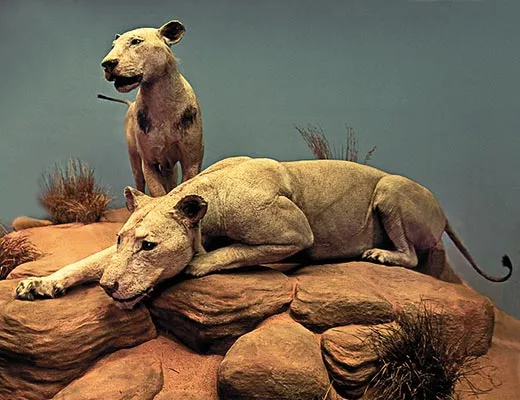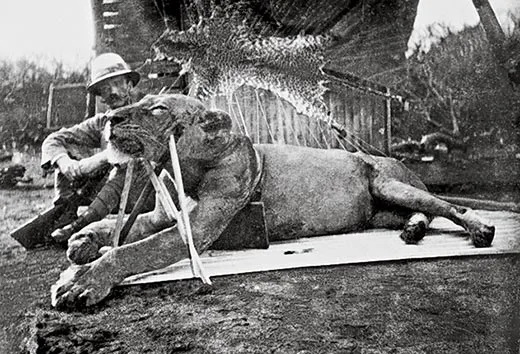Has Our Relationship With Wild Animals Changed Since The Time Of Colonel Patterson
/https://tf-cmsv2-smithsonianmag-media.s3.amazonaws.com/filer/Colonel-Patterson-first-Tsavo-Lion-631.jpg)
They are perhaps the globe's most notorious wild lions. Their ancestors were vilified more than than 100 years agone as the man-eaters of Tsavo, a vast swath of Republic of kenya savanna effectually the Tsavo River.
Bruce Patterson has spent the past decade studying lions in the Tsavo region, and for several nights I went into the bush-league with him and a team of volunteers, hoping to glimpse one of the beasts.
We headed out in a truck along narrow red dirt trails through thick scrub. A spotlight threw a slender beam through the darkness. Kudus, huge antelopes with curved horns, skittered abroad. A herd of elephants passed, their massive bodies silhouetted in the nighttime.
I evening just after midnight, we came upon three lions resting past a water pigsty. Patterson identified them as a four-year-former male he has named Dickens and two unnamed females. The three lions rose and Dickens led the two females into the scrub.
On such forays Patterson has come to amend understand the Tsavo lions. Their prides, with up to 10 females and just one male, are smaller than Serengeti king of beasts prides, which take upwards to 20 females and 2 or more than males. In Tsavo, male lions exercise not share power with other males.
Tsavo males look different besides. The most vigorous Serengeti males sport large dark manes, while in Tsavo they accept brusque, thin manes or none at all. "It's all about water," Patterson says. Tsavo is hotter and drier than the Serengeti, and a male with a heavy mane "would squander his daily water allowance just panting under a bush, with none to spare for patrolling his territory, hunting or finding mates."
But it's the lions' reputation for preying on people that attracts attending. "For centuries Arab slave caravans passed through Tsavo on the way to Mombasa," said Samuel Kasiki, deputy director of Biodiversity Inquiry and Monitoring with the Kenya Wildlife Service. "The death rate was loftier; information technology was a bad area for sleeping sickness from the tsetse fly; and the bodies of slaves who died or were dying were left where they dropped. So the lions may take gotten their gustatory modality for human flesh by eating the corpses."
In 1898, two lions terrorized crews amalgam a railroad span over the Tsavo River, killing—co-ordinate to some estimates—135 people. "Hundreds of men savage victims to these savage creatures, whose very jaws were steeped in blood," wrote a worker on the railway, a project of the British colonial authorities. "Bones, flesh, skin and blood, they devoured all, and left not a trace behind them."
Lt. Col. John Henry Patterson shot the lions (a 1996 film, The Ghost and the Darkness, dramatized the story) and sold their bodies for $five,000 to the Field Museum in Chicago, where, stuffed, they greet visitors to this solar day.
Bruce Patterson (no relation to John), a zoologist with the museum, continues to study those animals. Chemical tests of hair samples recently confirmed that the lions had eaten man flesh in the months earlier they were killed. Patterson and his colleagues estimate that i lion ate 10 people, and the other about 24—far fewer than the legendary 135 victims, merely nonetheless horrifying.
When I arrived in Nairobi, word reached the capital that a king of beasts had merely killed a woman at Tsavo. A cattle herder had been devoured weeks before. "That's not unusual at Tsavo," Kasiki said.
Notwithstanding, today's Tsavo lions are not innately more bloodthirsty than other lions, Patterson says; they attack people for the same reason their forebears did a century ago: "our encroachment into what was in one case the territory of lions." Injured lions are specially dangerous. One of the original man-eaters had astringent dental illness that would accept made him a poor hunter, Patterson plant. Such lions may learn to assail people rather than game, he says, "because we are slower, weaker and more defenseless."
Paul Raffaele'due south book Amongst the Peachy Apes will exist published in February.
Source: https://www.smithsonianmag.com/science-nature/man-eaters-of-tsavo-11614317/
Posted by: mcnultyshosselame.blogspot.com



0 Response to "Has Our Relationship With Wild Animals Changed Since The Time Of Colonel Patterson"
Post a Comment